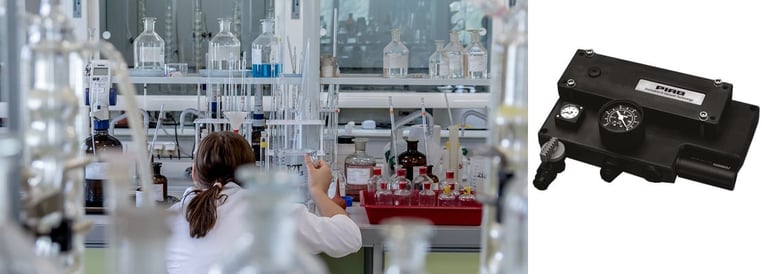- News
- Easy separation of samples with vacuum technology from Piab
Easy separation of samples with vacuum technology from Piab

Sample separation is a regular task in chemical laboratories to conduct further research. Piab’s Lab Vac vacuum pumps ensure an energy as well as cost efficient and reliable process based on a standard compressed air system.
When it comes to separation rotary evaporation, vacuum filtration, degassing and gel drying as a prerequisite for electrophoresis are common methods to isolate the products of synthesis of a reaction from liquid solvents or gases. Vacuum technology plays an important role in all thrse techniques.
While water aspiration is a simple technique with lowest installation though highest operation costs, the poor vacuum quality is its biggest draw back. Additionally, its non-sustainable use of water as its resource to produce a vacuum needs to be taken into account in an increasing number of locations facing dry periods with little rainfalls as it can have a serious impact on water supply. This fact is furthermore likely to drive operations costs up as utility costs for municipal water increase.
Therefore, the choice is usually either between a central vacuum system or a compressed air driven solution with portable vacuum pumps, such as Piab’s Lab Vac multi-stage ejectors.
As central vacuum systems may already be available in a laboratory, the quality of the vacuum depends on the number of users limiting the number of filtrations that can be conducted simultaneously. If an additional system is installed it requires dedicated space for the pump with sufficient cooling capacity to cope with the high heat load generated by the system. While marginally cheaper in operating costs than water aspiration, it is prone to higher repair costs due to ineffective user based solvent traps, which can shorten the pump lifetime as well a frequent changes of the pump oil due to solvent contamination.
With installation costs similar or up to 25 percent lower than central vacuum depending on how flexible the pumps are used, a compressed air driven solution with Piab’s Lab Vac pumps is the most economical. This is particularly true as operation costs are nearly 80 percent lower while maintenance costs are negligible as it operates without moving parts. Compared to typical electrical vacuum pumps as used in central vacuum systems, Piab’s Lab Vac units are considered maintenance-free as there is no oil change needed and no electric motor to spark or wear out nor do they generate heat during operation.
While it requires sufficient air capacity to drive the selected number of pumps, the Lab Vac ejectors are fully portable and can hence be operated flexibly where needed without suffering losses on the vacuum even if a longer distance needs to be covered by hoses to the central air system. As they provide a consistent vacuum level at the point of use at all locations the quality of the vacuum is excellent. Hence, Piab’s Lab Vacs are the most reliable vacuum source ensuring repeatability and comparability of results. This is important as the samples derived from rotary evaporation or vacuum filtration usually form the base of further tests that depend on the quality and purity of the base material for rendering trustworthy results.
Piab’s Lab Vac multi-stage ejectors are characterized by high vacuum flows and high vacuum levels. This is important in the rotary evaporation of solvents with higher boiling points such as water as well as in gel drying – another application in which Piab’s Lab Vac pumps are routinely used. Here relatively high flow rates are required as there can be high leakage rates in gel drying which is used for instance in electrophoresis to separate and determine DNA fragments or proteins or for storage of these materials for later usage.
In both applications vacuum regulation is beneficial. In rotary evaporation it helps to prevent bumping of samples by providing an even rate of evaporation. In gel drying it enables setting the optimal pressure to keep gels from tearing. For this purpose, Piab’s Lab Vac pumps can be equipped with an additional Vacustat check valve. It allows not only to finely set and adjust the vacuum to the exact level needed but also enables intermittent operation – contrary to traditional sources such as electric pumps or water ejectors which need to run continuously. Hence, when the required vacuum level has been reached, the Vacustat reduces the pumps to run only to maintain the pre-set vacuum level thereby minimizing the energy consumption to the lowest possible level.
As laboratory equipment is usually exposed to a harsh environment, chemical resistance plays an important role. Piab’s Lab Vac pumps are available entirely of PPS with seals made of EPDM, Viton or KalRez® depending on the aggressiveness of the solvents used.
Albeit water jets or electric pumps the multi-stage vacuum ejectors are extremely operator friendly as they do not produce constant noise from numerous moving parts. This allows continuous sample extraction over a long period of time without tiring.
Specifically engineered for use in the modern laboratory, the Piab Lab Vac is designed to be a very small, portable vacuum device that can be mounted near the point-of-use freeing up bench and aisle space and providing more work area to the researcher. At the same time, it eliminates line losses and increases reliability in any type of sample separation be it rotary evaporation, vacuum filtration, degassing or gel drying.